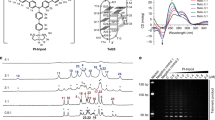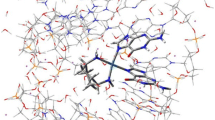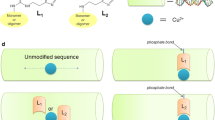Abstract.
The novel phase II anticancer drug BBR3464 ([{trans-PtCl(NH3)2}2-µ-{trans-Pt(NH3)2(NH2(CH2)6NH2)2}](NO3)4) forms a 1,4-interstrand cross-link adduct with the self-complementary DNA octamer 5′-d(ATG*TACAT)2-3′, with the two platinum atoms coordinated in the major groove at the N7 positions of guanines that are four base pairs apart on opposite DNA strands. The "central" tetraamine linker [trans-H2N(CH2)6NH2Pt(NH3)2NH2(CH2)6NH2] was located in or close to the minor groove. The adduct was characterized and analyzed by MS, UV and NMR spectroscopy. NMR analysis of the adduct shows strong H8/H1′ intraresidue crosspeaks observed for the A1 and A7 resonances, consistent with a syn conformation for these bases which is usually not observed for adenine residues and bases not directly involved in the cross-link in oligonucleotides. The strong intraresidue H8/H1′ crosspeak is also observed for G3. Examination of the structure thus reveals unusual cooperative effects unique to this class of anticancer drugs and is the first demonstration of cooperative effects in solution for an anticancer drug. The significant characteristic of the structure is the lack of severe DNA distortion such as a kink, directed bend or significant unwinding of the helices which are characteristic for DNA adducts of mononuclear complexes. This may contribute to the lack of protein recognition of the cross-link by HMG-domain proteins, a biological consequence significantly different from that of mononuclear complexes such as cisplatin. Since DNA is the principal target in vivo for these Pt cross-linking agents, the unique structural perturbations induced by BBR3464 cross-links are likely related to its increased cytotoxicity and antitumor activity as compared to cisplatin (cis-DDP).Electronic supplementary material is available if you access this article at http://dx.doi.org/10.1007/s00775-002-0383-x. On that page (frame on the left side), a link takes you directly to the supplemtary materials.
Similar content being viewed by others
Author information
Authors and Affiliations
Additional information
Electronic Publication
Rights and permissions
About this article
Cite this article
Qu, Y., Scarsdale, N.J., Tran, MC. et al. Cooperative effects in long-range 1,4 DNA-DNA interstrand cross-links formed by polynuclear platinum complexes: an unexpected syn orientation of adenine bases outside the binding sites. J Biol Inorg Chem 8, 19–28 (2003). https://doi.org/10.1007/s00775-002-0383-x
Received:
Accepted:
Issue Date:
DOI: https://doi.org/10.1007/s00775-002-0383-x




